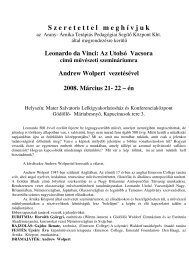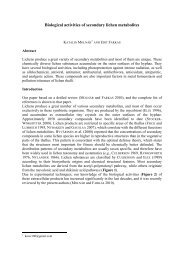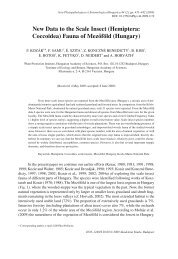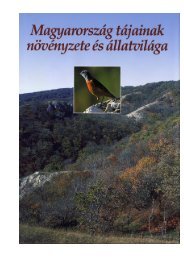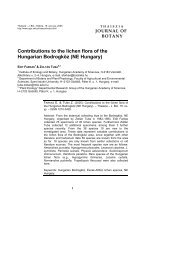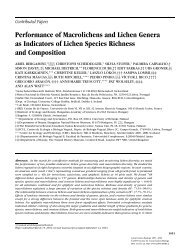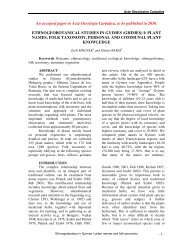Current Results on Biological Activities of Lichen ... - Lichens and Me
Current Results on Biological Activities of Lichen ... - Lichens and Me
Current Results on Biological Activities of Lichen ... - Lichens and Me
Create successful ePaper yourself
Turn your PDF publications into a flip-book with our unique Google optimized e-Paper software.
162 K. Molnár <strong>and</strong> E. Farkas · <strong>Biological</strong> <strong>Activities</strong> <strong>of</strong> <strong>Lichen</strong> Substances<br />
Structurally closely related metabolites <strong>of</strong>ten<br />
have essentially different biological acti<strong>on</strong>s. Hager<br />
et al. (2008) reported that barbatic <strong>and</strong> diffractaic<br />
acids, which differ in <strong>on</strong>ly <strong>on</strong>e functi<strong>on</strong>al<br />
unit, have diverging biological effects. Barbatic<br />
acid (extracted from a metabolite-forming Heterodea<br />
muelleri mycobi<strong>on</strong>t culture) str<strong>on</strong>gly inhibits<br />
the growth <strong>of</strong> Trebouxia jamesii (the photobi<strong>on</strong>t<br />
in H. muelleri) <strong>and</strong> slows down the mitosis rate<br />
<strong>of</strong> the alga at a c<strong>on</strong>centrati<strong>on</strong> comparable to the<br />
quantity found in the lichen thallus (in nature). It<br />
can cause cell death in higher c<strong>on</strong>centrati<strong>on</strong>s. At<br />
the same time, diffractaic acid (from a mycobi<strong>on</strong>t<br />
culture, as before) has no effect <strong>on</strong> algal growth<br />
at all. On the basis <strong>of</strong> this result, barbatic acid<br />
may regulate algal growth <strong>and</strong> mitosis in the lichen<br />
thalli.<br />
Antioxidant Activity<br />
Free radicals (reactive oxygen species, such as<br />
the hydroxyl radical, superoxide ani<strong>on</strong>, <strong>and</strong> hydrogen<br />
peroxide, <strong>and</strong> reactive nitrogen species, such<br />
as nitric oxide) play an important role in many<br />
chemical processes in the cells, but they are also<br />
associated with unwanted side effects, causing cell<br />
damage. They attack proteins <strong>and</strong> nucleic acids, as<br />
well as unsaturated fatty acids in cell membranes.<br />
Food deteriorati<strong>on</strong>, aging processes <strong>and</strong> several<br />
human chr<strong>on</strong>ic diseases, such as Alzheimer’s disease,<br />
atherosclerosis, emphysema, hemochromatosis,<br />
many forms <strong>of</strong> cancer (for example, melanoma),<br />
Parkins<strong>on</strong>’s disease, <strong>and</strong> schizophrenia, may<br />
be related to free radicals. Oxidative stress occurs<br />
also in lichen thalli, <strong>and</strong> sec<strong>on</strong>dary compounds afford<br />
protecti<strong>on</strong> against free radicals generated by<br />
UV light (Marante et al., 2003).<br />
The damaging effects <strong>of</strong> free radicals can be<br />
ameliorated by free radical scavengers <strong>and</strong> chain<br />
reacti<strong>on</strong> terminators – enzymes such as superoxide<br />
dismutase, catalase, glutathi<strong>on</strong>e peroxidase,<br />
<strong>and</strong> glutathi<strong>on</strong>e reductase, as well as antioxidants<br />
such as glutathi<strong>on</strong>e, polyphenols (lignins, flav<strong>on</strong>oids),<br />
carotenoids, melanins, <strong>and</strong> vitamins E <strong>and</strong><br />
C.<br />
Since synthetic antioxidants are <strong>of</strong>ten carcinogenic,<br />
finding natural substitutes is <strong>of</strong> great interest.<br />
<strong>Lichen</strong>s have been found to c<strong>on</strong>tain a variety<br />
<strong>of</strong> sec<strong>on</strong>dary lichen substances with str<strong>on</strong>g antioxidant<br />
activity. These are substances which have<br />
high ability to scavenge toxic free radicals due<br />
their phenolic groups. Hidalgo et al. (1994) reported<br />
the antioxidant activity <strong>of</strong> some depsides, such<br />
as atranorin (isolated from Placopsis sp.) <strong>and</strong> divaricatic<br />
acid (isolated from Protousnea malacea),<br />
<strong>and</strong> depsid<strong>on</strong>es, such as pannarin (isolated from<br />
Psoroma pallidum) <strong>and</strong> 1’-chloropannarin (isolated<br />
from Erioderma chilense). All <strong>of</strong> these sec<strong>on</strong>dary<br />
compounds inhibited rat brain homogenate<br />
auto-oxidati<strong>on</strong> <strong>and</strong> β-carotene oxidati<strong>on</strong>, <strong>and</strong><br />
depsid<strong>on</strong>es were found to be the most effective.<br />
Russo et al. (2008) found that both sphaerophorin<br />
(depside) <strong>and</strong> pannarin (depsid<strong>on</strong>e) inhibited superoxide<br />
ani<strong>on</strong> formati<strong>on</strong> in vitro, pannarin being<br />
more efficient, c<strong>on</strong>firming Hidalgo et al. (1994).<br />
A methanol extract <strong>of</strong> Lobaria pulm<strong>on</strong>aria reduced<br />
the oxidative stress induced by indomethacin<br />
in the stomachs <strong>of</strong> rats, increasing the levels<br />
<strong>of</strong> superoxide dismutase <strong>and</strong> glutathi<strong>on</strong>e peroxidase<br />
(Karakus et al., 2009). Similarly, usnic acid<br />
was shown to be a gastroprotective compound,<br />
since it reduced oxidative damage <strong>and</strong> inhibited<br />
neutrophil infiltrati<strong>on</strong> in indomethacin-induced<br />
gastric ulcers in rats (Odabasoglu et al., 2006).<br />
<strong>Me</strong>thanol extracts <strong>of</strong> Dolichousnea l<strong>on</strong>gissima<br />
(as Usnea l<strong>on</strong>gissima) <strong>and</strong> Lobaria pulm<strong>on</strong>aria<br />
have been shown to have significant antioxidant<br />
effects in vitro (Odabasoglu et al., 2004). According<br />
to Luo et al. (2009), the extreme c<strong>on</strong>diti<strong>on</strong>s<br />
in Antarctica (such as low temperature, drought,<br />
winter darkness, high UV-B <strong>and</strong> solar irradiati<strong>on</strong>)<br />
increase oxidative stress, c<strong>on</strong>sequently, antarctic<br />
lichens c<strong>on</strong>tain larger amounts <strong>of</strong> antioxidant<br />
substances <strong>and</strong> have higher antioxidant activity<br />
than tropical or temperate lichens. An acet<strong>on</strong>e<br />
extract <strong>of</strong> Umbilicaria antarctica was found to<br />
be the most effective antioxidant in free radical<br />
<strong>and</strong> superoxide ani<strong>on</strong> scavenging, as well as in reducing<br />
power assays am<strong>on</strong>g tested lichen species<br />
collected from King George Isl<strong>and</strong>, Antarctica.<br />
Lecanoric acid was identified as the main active<br />
compound. <strong>Me</strong>thanol-water extracts <strong>of</strong> five lichens<br />
(Caloplaca regalis, Caloplaca sp., Lecanora<br />
sp., Ramalina terebrata, Stereocaul<strong>on</strong> alpinum)<br />
from Antarctica were screened for their antioxidant<br />
effects by Bhattarai et al. (2008), who found<br />
varying antioxidant success against the stable free<br />
radical diphenylpicrylhydrazyl (DPPH) <strong>on</strong> a TLC<br />
plate.<br />
All <strong>of</strong> these studies show that lichens <strong>and</strong> lichen<br />
substances might be novel sources <strong>of</strong> natural<br />
antioxidants.



